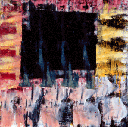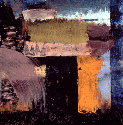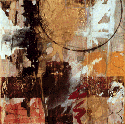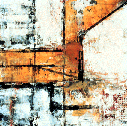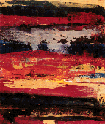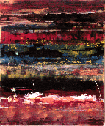I start these paintings by messing around with different ways of applying
paint. In the smaller paintings from 1995, I used corrugated cardboard, cut
rubber, a toy truck, a ruler, a roller, stamps, squeegees, a metal grille,
plastic...things (anything but a brush). I ask myself "what would happen if..."
I paint a straight line, pour a blob of paint, smear a smear, roll a circle,
print a pattern on a piece of wood; can I make all that into a painting? Can I
use bubble-gum pink and be taken seriously? What will happen if I use oil
paints and water-based paints together? Am I a madman? Or what? Shellacs,
varnishes, urethane paint, powdered pigments, all create interesting effects
when used in totally inappropriate ways.
As the paintings got a little larger, I began to use tape extensively. I tape
areas, pour and roll paint, remove the tape, see what happens. Sometimes the
paint seeps under the tape, sometimes I can't get the tape off. Sometimes I'll
try for a subtle color effect; if that doesn't work, I'll pour on something
strident; I sand down the paint, sand down the wood. If a thousand monkeys
worked at a painting long enough, they could create a masterpiece. I strive to
be a thousand monkeys.
Painting is a language. The vocabulary is color, liquid, texture, shape, edge;
the meanings arise out of the juxtaposition of these things. I try to stay open
to what happens in the process of painting, and open to the shifts in possible
meanings. A painting can be about a South American sunset, a train, a river, an
exchange student from Saudi Arabia, a moment in history; it can be jazz, or
blues, ballroom dancing, the jitterbug, a dance in the dark, the dark at the top
of the stairs; it is both a fact, and as real as a dream. It can shift meanings
from day to day, from moment to moment. It is about all of this, and whatever
else has made up the artist's life, as it spills onto the surface.
|
||
